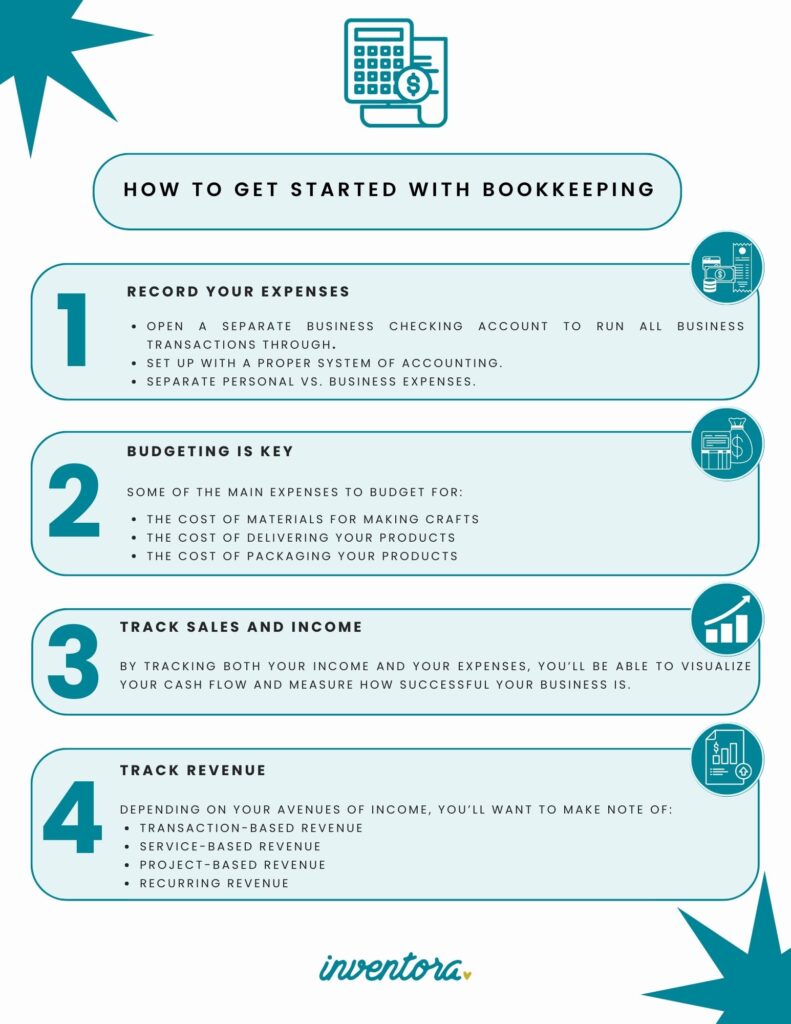
As hand makers, the administrative part of the business is probably our least favorite. It is common to start guessing at numbers of costs and inventory quantities when we aren’t best organizing our business. This leads to actually having no idea what is going on in our businesses. Without this accurate data, we won’t understand what works, what doesn’t work, or if it’s working at all. As well as leave our financial state in shambles. This is why understanding how to start bookkeeping for craft businesses is so important.
Bookkeeping is one of the most important parts of maintaining a business in order to have success and growth. Hand-in-hand, it is also our responsibility to pay taxes each quarter or year. If we fail to pay, we could have a tax collector or auditor calling sooner rather than later. For us to be able to not worry about these common issues, we need to know our exact numbers. As well as the financial health of our business. This can all be completed with the simple help of bookkeeping.
The Significance of Precise Bookkeeping

Bookkeeping involves verifying receipts, depositing payments into a bank account, and keeping clear records. This is all done so that every detail of our financial information is easily accessible when needed. This is important because accurate accounting records are essential to a company’s sustainability. Accurate bookkeeping helps a business manage its cash flow, meet its financial obligations and plan its investments.
To understand how to start bookkeeping for craft businesses, we need to become familiar with it. We must set up a chart of accounts, record all financial transactions, reconcile bank accounts, and run monthly financial statements.
This article will help craft businesses improve their knowledge of bookkeeping. While demonstrating the best practices to improve its financial record keeping.
Why is Bookkeeping Important for Businesses?
Proper bookkeeping helps craft businesses maintain accurate financial records, which are a requirement by law for taxation. Aside from the legal requirements, good bookkeeping offers practical business benefits. Some of the reasons why good bookkeeping is essential to a successful business are:
- Budgeting: When income and expenses are recorded, it is easier to review our financial resources and estimate cash flow. It’s also beneficial to look at our financial state at any given time, which can be easily done with accurate budgeting through bookkeeping.
- Organization: Bookkeeping is an important tool for other businesses and their records. For example, the IRS or accountants who have an interest in the financials of our business. When our records are well organized, it is easier to locate and provide information when needed and it can be easier to file our taxes.
- Analysis: Bookkeeping helps our companies generate financial statements. These statements can be used as a tool to track cash flow and assist us in analyzing our company’s strengths and weaknesses.
- Planning: Financial statements can also indicate initiatives that can help business owners make plans for the future.
Components of Bookkeeping

Bookkeeping provides the records necessary to understand a business’s finances. As well as recognize any monetary issues that may need to be aware of. Proper planning and scheduling are key. This is because staying on top of records on a weekly or monthly basis will provide a clear overview of an organization’s financial health.
For every type of business, bookkeeping includes several components and steps, including:
- Documenting every financial transaction (payments and expenses)
- Recording all debits and credits
- Sending invoices and processing payments
- Preparing financial statements (balance sheet, income, and cash flow)
- Conducting daily banking activities
- Completing payroll functions
Each component of bookkeeping is a critical aspect of any business operation that aims to maintain accurate financial records. By understanding the components of bookkeeping and taking the necessary steps to implement them, businesses can better manage their finances. While also make informed decisions.
Beginning Bookkeeping
Bookkeeping plays a vital role in the success of any small business, including those selling handmade crafts. Without well-organized financial information, it can be challenging to understand your business’s financial health and address any monetary issues. A critical component of bookkeeping is recording all business expenses. Which is especially important for handmade craft businesses that frequently make and ship products to fulfill customer orders.
To keep track of the numerous expenses associated with running a craft business, it’s essential to have a reliable system in place. Implementing a handmade inventory management software like Inventora can help organize your costs and ensure they’re easily accessible in the future. Keeping an accurate record of your expenses is crucial for claiming deductions. This also is important for reducing your tax bill, which can be significant for small businesses.
Therefore, it’s crucial to explore the range of business expenses you can claim while doing taxes. This will help to maximize your tax deductions. Moreover, if you operate your craft business from home, remember to take advantage of the expenses. You can claim many expenses while working from home.
Here are some basic files and procedures you should put in place to record your expenses:
Open a separate business checking account to run all business transactions through. While this may seem like a basic step, you must understand two things. It is crucial to ensure that you don’t mix your personal and business finances. Paying for business expenses out of your personal account or vice versa can lead to confusion. Inaccurate records and potential tax issues can also cause issues internally.
By having a separate account, you can keep track of your business’s financial health. While also easily identifing any discrepancies or issues. This provides a more professional image to your customers and partners. As it demonstrates that the business is taken seriously and is committed to maintaining proper financial records.
Develop a proper accounting system. Developing a sound accounting system is crucial for any small business, including a craft business. A fundamental step towards this goal is ensuring the business’s bank account is reconciled each month to its accounting records. This ensures that your financial information is accurate and up-to-date, allowing you to make informed decisions about your business.
This also helps to ensure that you don’t miss any expenses or income. And provides a clear picture of your cash flow. With a reliable accounting system in place, you can streamline your financial management and focus on growing your business.
For any business expense that would be borderline personal vs. business you should handle things a bit differently. A business should write on the receipt exactly what was purchased and why it’s in need for the company. Then scan it and save it to either your accounting software or some sort of online file document system.
Record Your Expenses

Recording your expenses is a crucial aspect of maintaining proper bookkeeping for your small business. While it can be time-consuming, it is essential to keep track of all financial transactions and to start bookkeeping for craft businesses. Do so to understand your business’s financial health.
Some expenses you should record in your bookkeeping include:
Payroll: Depending on the type of business you have, you may pay yourself as an employee of your company. Or you can pay yourself via personal checks. It is crucial to calculate payroll expenses accurately. If you are unsure of how to handle payroll, seek guidance from a tax accountant.
Outside Services/Contract Work Expenses: These expenses may include fees paid to designers. As well as, virtual assistants, or photographers who provide regular services to your business.
Office Supplies: Writing utensils, printing supplies, organizational tools, and paper are essential to run your business smoothly.
Cost of Goods Sold (COGS): COGS includes all expenses related to producing your products. Including the direct cost of materials, labor, and overhead like rent.
By recording your expenses accurately, you can identify areas where you can reduce expenses. While making informed decisions to improve your business’s financial health.
Budgeting is Key
If you’re running a craft business, you’re probably already familiar with budgeting. However, it’s important to create a budget frequently. Whether it’s weekly or monthly, since your primary source of income is from selling handmade crafts. This frequent budgeting is critical because of the variety of expenses that come with running a craft business. Such as material costs, delivery expenses, and packaging costs. This must be understood when you start bookkeeping for craft businesses
Without a budget, you may overspend on one of these expenses and not have enough to cover the others. Thus leading to issues with fulfilling orders or creating new stock. Along with production expenses, it’s also important to consider marketing and operating expenses in your budget.
To make the budgeting process easier, consider automating your business as much as possible. Software systems like Inventora can help you determine the cost of your materials, products, and supply orders. Making it unnecessary for you to perform calculations manually. This saves time and effort, leaving you with more time to focus on growing your business.
Track Sales and Income
Proper bookkeeping requires not only keeping track of your expenses but also your sales and income. Monitoring your income allows you to assess the popularity of your products. Plus measure the success of your business by comparing your current income to previous months. By tracking both your income and expenses, you can gain insight into your cash flow. Which represents the movement of money in and out of your business.
By using accounting software, you can save valuable time by connecting it to your business checking account. And you are enabling automatic entry recording. With a healthy cash flow, you can ensure that your business is thriving.
Track Revenue
When running a handmade business, it’s important to have a variety of revenue streams. This goes hand-in-hand with how to start bookkeeping for craft businesses This can make tracking income more complex than simply knowing your sales numbers. Depending on your avenues of income, you’ll want to make note of your revenue. This included transaction-based revenue, service-based revenue, project-based revenue, and recurring revenue. This is done to have a more comprehensive understanding of a business’s financial health. By tracking your revenue in detail, you can identify areas of strength and opportunities for growth.
In addition to tracking revenue by stream, it’s also important to track revenue by customer. By keeping track of which customers are generating the most revenue, you can focus your marketing efforts. Such as on retaining those customers and attracting similar ones. Moreover, tracking revenue by customer allows you to identify areas where you can improve your sales strategy. Or target specific segments of your customer base.
Using accounting software can also make tracking revenue easier. By automating the process and generating reports you can avoid making big mistakes. This information will provide insights into your business’s revenue streams. With accurate and detailed revenue tracking, you can make informed decision about your business. Such as choices about pricing, product offerings, and marketing strategies to grow your business.
To start bookkeeping for your handmade business, download our step-by-by guide below!

Concluding Remarks
When it comes to keeping up with the records in your craft business, it may be a task that you are comfortable tackling on your own. While it may seem daunting at first, the system chosen to use doesn’t need to be overly complicated. Especially, if you have just a few or no employees. The most important aspects of doing your own bookkeeping are staying organized and keeping track of all the important details.
To get started, a business must first decide on the bookkeeping system it wants to use. You can choose from a variety of options such as an online program, paid software, or even a simple spreadsheet. Once you have selected the system that works best for you, set aside a dedicated time. This can be either weekly or biweekly to review your bookkeeping records. During this time, you should reconcile transactions and complete any necessary data entry.
Finally, it is important to decide on how you will store all of your receipts and documents. You can either keep hard copies or opt for electronic files by scanning your paperwork. By following these steps, a business can ensure that their bookkeeping records are organized, accurate, and up to date. Thus, ultimately help your business succeed and will help you to understand how to start bookkeeping for craft businesses today.
If you’re running a handmade craft business, managing inventory and tracking expenses can be time-consuming and overwhelming. That’s where Inventora comes in. By signing up for our newsletter, you’ll receive updates on the latest features. Plus, tips on how to streamline your business operations. Try Inventora for free to see if it’s the right fit for your handmade inventory management and bookkeeping needs. With Inventora, you can spend less time on bookkeeping and more time on creating beautiful handmade products.


